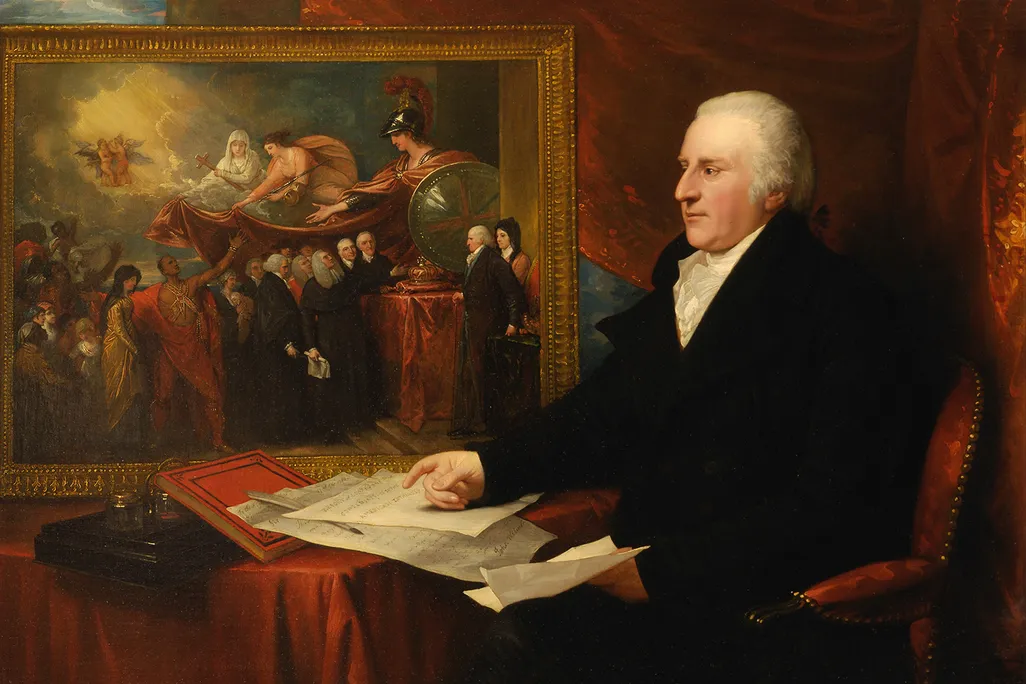A Smithsonian magazine special report
American colonists who aligned with the British lost their lands, their reputations and sometimes even their lives
/https://tf-cmsv2-smithsonianmag-media.s3.amazonaws.com/accounts/headshot/greg2.png)
Greg Daugherty - History Correspondent
June 4, 2025

The popular image of the American Revolution may be of fired-up colonists united in the fight to overthrow their British rulers. But the reality was far more complicated. Many historians estimate that at least 15 to 20 percent of the population remained loyal to the crown, some even taking up arms against their rebellious neighbors and fighting alongside the British.
What’s more, much of the population, “probably a statistical majority, [just] wanted to get on with their own lives without worrying about declaring their allegiance to one side or the other,” writes historian Joseph J. Ellis in American Creation: Triumphs and Tragedies at the Founding of the Republic.
The loyalists, Tories or friends of the king, as they were variously called, would pay a particularly steep price for choosing what turned out to be the losing side. (Tories was the most derisive term for them; the British, in turn, called the rebels Yankees, which was also considered an insult in those days.)
/https://tf-cmsv2-smithsonianmag-media.s3.amazonaws.com/filer_public/82/eb/82ebb899-f207-44a6-87e5-be0b3033ab3a/the_savages_let_loose_or_the_cruel_fate_of_the_loyalists_met_dp877005.jpg) A satirical illustration reflecting the dissatisfaction felt by British loyalists at the end of the American Revolution
Public domain via Wikimedia Commons
A satirical illustration reflecting the dissatisfaction felt by British loyalists at the end of the American Revolution
Public domain via Wikimedia Commons
Some loyalists were tarred and feathered, scalped, or even hanged. Many more were ostracized or found their businesses boycotted. Much of their property was confiscated through a series of laws. Tens of thousands went into exile, a large portion of them to Nova Scotia, to other parts of Canada or across the Atlantic Ocean to England. A significant number of Black loyalists emigrated to the British West Indies or, after finding Canada inhospitable, to the West African colony of Sierra Leone.
Loyalists came from all walks of life: wealthy merchants and landowners, everyday laborers and shopkeepers, and both free and enslaved Black people. They were especially numerous in parts of New York, Pennsylvania and the Southern Colonies.
New York City, which the British occupied for most of the war, was a loyalist stronghold until 1783, when General George Washington’s troops retook it. In November 1776, more than 500 loyalists in the city signed a document known as the Declaration of Dependence—a defiant reply to the founders’ Declaration of Independence, which was signed nearly five months earlier.
Loyalists before and during the American Revolution
Even before the nascent United States declared its independence from Britain on July 4, 1776, local revolutionary groups began requiring their neighbors to pledge loyalty to the cause. (The British also imposed their own loyalty oaths on colonists.) “From mid-1775, individuals who refused to take an oath risked not just ostracism but arrest, imprisonment, property confiscation and banishment,” writes historian Holger Hoock in Scars of Independence: America’s Violent Birth.
In some cases, the punishment could be even worse. In August 1775, for example, Thomas Brown, a plantation owner with loyalist sympathies, was dragged from his house in South Carolina by a mob of rebels. After cracking his skull with a musket butt, Hoock writes, they “tied him to a tree while still unconscious, tarred his legs, burned his feet to the point where he lost two toes and partially scalped him.” At that point, he signed an oath, although he later recanted it and commanded a loyalist regiment called the King’s Rangers.
/https://tf-cmsv2-smithsonianmag-media.s3.amazonaws.com/filer_public/be/ce/bece1a72-768a-489f-9b1e-7b0399e6c704/a_new_method_of_macarony_making_as_practised_at_boston_in_north_america_bm_193505222120c.jpg) A satirical illustration of a man being tarred and feathered
Public domain via Wikimedia Commons
A satirical illustration of a man being tarred and feathered
Public domain via Wikimedia Commons
Like Brown, some 19,000 loyalists “formally took up arms in the service of the crown to suppress the American rebellion,” wrote historian Paul H. Smith in a 1968 journal article. (That contrasts with the roughly 231,000 soldiers who served in the Continental Army at one point or another, plus another 145,000 who joined Colonial militias.)
Simply associating with a loyalist could be dangerous. A New Englander named Jesse Dunbar “broke a boycott and purchased an ox from a particularly hated loyalist, [then] found himself paraded through town sealed inside its carcass,” historian Timothy Compeau, author of Dishonored Americans: The Political Death of Loyalists in Revolutionary America, tells Smithsonian magazine.
Both sides would commit atrocities during the war, and loyalists were far from passive victims. In one notorious 1778 example known as the Cherry Valley Massacre, loyalist troops, along with their British and Native American comrades in arms, attacked a small fort and nearby settlement in upstate New York, killing 16 soldiers and 32 civilians, primarily women and children. “The murders were blamed on Indians, but survivors said they saw loyalists amid the carnage,” historian Thomas B. Allen writes in Tories: Fighting for the King in America’s First Civil War. “A man identified as a Tory sergeant named Newbury was seen murdering a young girl by driving a tomahawk into her skull.”
Still, the outright killing of loyalist noncombatants was relatively rare—despite an apparently popular riddle of the day that asked, “What is a Tory?” The answer: “A Tory is a thing whose head is in England and its body in America‚ and its neck ought to be stretched.”
Instead, the revolutionaries relied on more subtle but equally effective means: publicly humiliating prominent loyalists and destroying their stature in the local community.
/https://tf-cmsv2-smithsonianmag-media.s3.amazonaws.com/filer_public/49/50/49503310-b173-4031-8946-e98327c11473/williamsburg.jpg) A 1775 British print of loyalists being forced to sign measures drawn up by patriots in Williamsburg, Virginia, the previous year
Public domain via Wikimedia Commons
A 1775 British print of loyalists being forced to sign measures drawn up by patriots in Williamsburg, Virginia, the previous year
Public domain via Wikimedia Commons
“Some of the insults and attacks might not seem that bad to modern eyes, but within the cultural context of the 18th century, they were charged with meaning and could be devastating,” Compeau says. “To insult a man with impunity, to vandalize his house, insult his family, steal his wig and eventually take his property was to strip away all the things that made him a gentleman.” The historian cites one loyalist who described this treatment as “penalties more severe than death itself.”
Some states passed “test laws” requiring free adult men to pledge their loyalty to the cause or face penalties that could include fines, taxes, the loss of the right to vote and the confiscation of property. They could also be forced to leave the state, with some fleeing to British-held territory and others leaving the country altogether.
In Westchester County, north of New York City, loyalists were sometimes allowed to stay on their land even after they had lost the title to it—at least until 1783, the year that the Treaty of Paris formally ended the war. “That’s when they settled scores and kicked them out,” David Osborn, site manager and historian at the county’s St. Paul’s Church National Historic Site, tells Smithsonian.
One way that local officials disposed of the confiscated land was by rewarding their allies, Osborn says. In 1784, for example, the New York Assembly presented the influential pamphleteer Thomas Paine with close to 300 acres in New Rochelle, New York, where he lived out his days and was initially buried.
Loyalists’ fate after the American Revolution
The Treaty of Paris recognized the U.S. as a sovereign nation and addressed a variety of other issues that remained to be resolved in the war’s aftermath. One was the restitution of property that had been confiscated from loyalists.
But the treaty’s final wording left a large loophole, requiring only that the U.S. Congress “earnestly recommend” that state legislatures follow through on this provision, essentially giving the states the right to ignore the recommendation, as many happily did.
Of the treaty’s three American signers—John Adams, John Jay and Benjamin Franklin—Franklin was said to have taken the harshest line against the loyalists. Many historians attribute that stance to the bitterness he felt toward his illegitimate son, William Franklin, who’d served as the royal governor of New Jersey before the revolution and later became a prominent loyalist.
/https://tf-cmsv2-smithsonianmag-media.s3.amazonaws.com/filer_public/d6/92/d6925ed6-696b-465c-b840-355f58da93c6/1595px-william_franklin_governor_of_new_jersey_nypl_b13049825-424716.jpg) William Franklin, the loyalist son of Benjamin Franklin
Public domain via Wikimedia Commons
William Franklin, the loyalist son of Benjamin Franklin
Public domain via Wikimedia Commons
William was imprisoned in Connecticut on July 4, 1776, and languished there for two years. During that time, writes historian Sheila L. Skemp in Benjamin and William Franklin: Father and Son, Patriot and Loyalist, “Benjamin did not lift a hand to secure his son’s freedom or even to make his imprisonment more comfortable.”
Biographer Stacy Schiff, in her book A Great Improvisation: Franklin, France and the Birth of America, comes to a similar conclusion, writing, “Franklin expressed no sympathy for his 48-year-old son, who—in taking up arms against him—angered him more even than had Great Britain.”
Franklin wasn’t alone in his anger. “In many ways, and for many years, William Franklin was considered the greatest traitor in the United States, second only to Benedict Arnold,” observes historian Jill Lepore in Book of Ages: The Life and Opinions of Jane Franklin, about the founding father’s little-known sister.
In 1782, William left for England, where he lived in exile for the rest of his life. In 1784, he wrote to his father, hoping to repair their relationship. But Franklin’s reply showed the depth of what he saw as his son’s betrayal. “Nothing has ever hurt me so much and affected me with such keen sensations as to find myself deserted in my old age by my only son, and not only deserted, but to find him taking up arms against me, in a cause wherein my good fame, fortune and life were all at stake,” he wrote back.
Who Were the Black Loyalists? - The Black Loyalist Heritage Centre

Franklin would even try to punish his son from the grave. “In his will, Franklin bequeathed to his only surviving son nothing more than some worthless land claims in Canada and the forgiveness of any debts he still owed him,” biographer Walter Isaacson writes in Benjamin Franklin: An American Life. To make sure William got the message, Franklin stipulated that his son’s paltry inheritance was due to “the part he acted against me in the late war.”
While the two Franklins never truly patched things up, much of the new nation moved on. “Tempers eventually cooled,” Compeau says, “and by the 1790s, Americans seemed to be broadly open to readmitting or forgiving loyalists, especially if they were from elite families who could advocate on their behalf. Few loyalists ever got their property back, but they could start over with family help.”
Some loyalists, however, had burned one bridge too many. “For them, the only honorable path was exile in Canada or elsewhere in the British Empire like the Bahamas,” Compeau says. “Yet even they kept in touch with their families in the United States and were reconciled in their own way with the new republic.”
/https://tf-cmsv2-smithsonianmag-media.s3.amazonaws.com/filer_public/d3/21/d321b936-51dc-453c-bfac-61ab23b3d1b5/screenshot_2024-12-09_at_53416_pm.png) A Black Loyalist woodcutter in Shelburne, Nova Scotia, in 1788
Nova Scotia Archives
A Black Loyalist woodcutter in Shelburne, Nova Scotia, in 1788
Nova Scotia Archives
.png)




